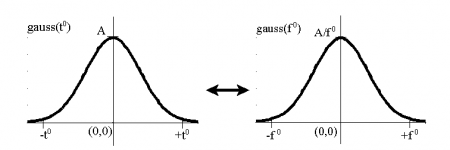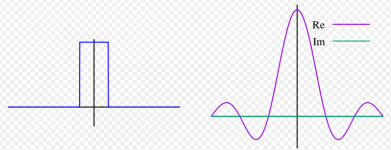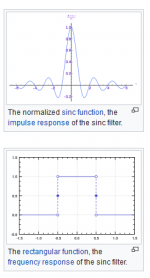You obviously didn't read my previous post. Bessel does alter phase response, as it goes. But Bessel is a slightly different animal from Linkwitz-Riley or Butterworth.Yup, this discussion opened up a big can of worms, as I expected.
My brother is also into high end audio, and has much more disposable income for tinkering and experimentation. Between my speakers and his (something like 10 different pairs), we spent a weekend fooling around with a minidsp, trying every filter option at every slope available with numerous speakers. We disconnected the built-in crossovers and went straight to amps, and tested each other to see which filters sounded the best. Even when not told which filter was being activated, we could tell when the best-sounding filter (to us) was being used... not just with one pair of speakers, but with all of them, every time. Maybe it's subtle. Maybe some training is needed to teach people to identify this characteristic that we can hear. But we can definitely hear it. Once equalization and time delay were tested and set, we both definitely thought the Bessel filters were the least-damaging to the natural-ness of the sound.
Just a reminder - the Linkwitz-Riley and Butterworth filters alter phase response; Bessel does not.
Bessel is a Gaussian response, similarly associated with notch and series filters.
LR2, BW3 and LR4 are Fourier responses, and associated with parallel filters. Which I prefer to call quadratic functions.
Gaussian response has the interesting property that the the transform is the same shape in the time and frequency domain, mathematically. It's a less sharp filter. It overlaps with adjacent bands in Radio.
Fourier gets a bit wilder. When you try to put the frequency response in a square box, a steep filter with less cross-channel interference, the time response approaches the Sinc function. Time's arrow plays a part too, but I don't want to go into that here.
All this stuff is familiar in loudspeakers, and radio techniques as it goes, at some point. But really to argue about it is pointless. The reason steeper filters sound better is that drivers aren't perfect and tend to distort. So we make compromises. Believe me, nature knows when you split a signal between two drivers and try to determine which one it comes out of. Measurable differences. Hence the Quantum Theory.
I suppose I could add another largely unfamiliar, but true, aspect of a channel, which is all your loudspeaker is. This comes from Information Theory. The maximum information rate a channel can pass is determined by the bandwidth and the signal-to-noise ratio. Which might mean that wide bandwidth is good, and distortion is bad. Seemples.
Attachments
Last edited:
^Did you eqalize each drive unit's acoustic response before setting xo in minisp?
I have heard very clear difference in sound when symmetric xo is a bit off vs. perfectly set. This includes acoustic slopes and timing.
It just might be that Bessel and asymmetric xos are not so demanding for accuracy.
I have heard very clear difference in sound when symmetric xo is a bit off vs. perfectly set. This includes acoustic slopes and timing.
It just might be that Bessel and asymmetric xos are not so demanding for accuracy.
I surprise myself sometimes, Juhazi.
I have come out strongly in favour of steep brickwall filters. Rather than the "Mickey Mouse" single coil and cap stuff which the lazy student would prefer.
Here's the state of play in our Universe at the moment. At a very high level of Physics thinking, we might live in a 10 or 24 dimensional String Theory Universe. Or a 4 dimensional spacetime Quantum Field Theory one.
Interestingly, IMO, Einstein's General relativity was a 4D spacetime in a 10D phase or tensor space. So there is room for manouevre for some good mathematics here, whichever version of reality you believe in.
My own view, is we should just pick a classic design that works well, and try and improve it. For instance, a 5" bass plus 3/4" tweeter is a decent bedroom speaker. How? Do it MTM or MTTM. Do it higher order filter. Less distortion or noise when driven loud. We know this sounds better.
I did ALL the filters at College. Digital and Analog. Even Chebysheff and the 3D spatial Fourier transform used in Radar. All the usual tradeoffs on time, frequency response and dispersion. Dispersion is especially interesting, IMO, it can be linear, inverse distance, or inverse square.
Here's more on steep brickwall filters. They have their issues. IMO, the Universe is saying: "Whatever tricks you do, we can always distinguish illusion from reality."
I have come out strongly in favour of steep brickwall filters. Rather than the "Mickey Mouse" single coil and cap stuff which the lazy student would prefer.
Here's the state of play in our Universe at the moment. At a very high level of Physics thinking, we might live in a 10 or 24 dimensional String Theory Universe. Or a 4 dimensional spacetime Quantum Field Theory one.
Interestingly, IMO, Einstein's General relativity was a 4D spacetime in a 10D phase or tensor space. So there is room for manouevre for some good mathematics here, whichever version of reality you believe in.
My own view, is we should just pick a classic design that works well, and try and improve it. For instance, a 5" bass plus 3/4" tweeter is a decent bedroom speaker. How? Do it MTM or MTTM. Do it higher order filter. Less distortion or noise when driven loud. We know this sounds better.
I did ALL the filters at College. Digital and Analog. Even Chebysheff and the 3D spatial Fourier transform used in Radar. All the usual tradeoffs on time, frequency response and dispersion. Dispersion is especially interesting, IMO, it can be linear, inverse distance, or inverse square.
Here's more on steep brickwall filters. They have their issues. IMO, the Universe is saying: "Whatever tricks you do, we can always distinguish illusion from reality."
Attachments
What does ^ and ^^ mean?Sorry, the ^ should have been ^^ My tablet didn't update the page.
Member
Joined 2009
Paid Member
Bessel filter
Why does it sound better? Probably it's the "maximally flat phase/group delay" characteristic. It could also be the controlled overshoot characteristic.
Chris
Why does it sound better? Probably it's the "maximally flat phase/group delay" characteristic. It could also be the controlled overshoot characteristic.
Chris
Last edited:
^ means a comment to the post just above
^^ means a comment to the post two steps above
And while you are typing somebody else posts and this doesn't make any sense anymore. ;-)
I surprise myself sometimes, Juhazi.
Here's the state of play in our Universe at the moment. At a very high level of Physics thinking, we might live in a 10 or 24 dimensional String Theory Universe. Or a 4 dimensional spacetime Quantum Field Theory one.
Interestingly, IMO, Einstein's General relativity was a 4D spacetime in a 10D phase or tensor space. So there is room for manouevre for some good mathematics here, whichever version of reality you believe in.
Bessel is a Gaussian response, similarly associated with notch and series filters.
LR2, BW3 and LR4 are Fourier responses, and associated with parallel filters. Which I prefer to call quadratic functions.
Gaussian response has the interesting property that the the transform is the same shape in the time and frequency domain, mathematically. It's a less sharp filter. It overlaps with adjacent bands in Radio.
Fourier gets a bit wilder. When you try to put the frequency response in a square box, a steep filter with less cross-channel interference, the time response approaches the Sinc function. Time's arrow plays a part too, but I don't want to go into that here.
Believe me, nature knows when you split a signal between two drivers and try to determine which one it comes out of. Measurable differences. Hence the Quantum Theory.
I fail to understand why you use references to "high level physics" when they are misapplied. For example:
- Multidimensional string theory is waning as a correct version of reality. They kept adding dimensions to solve problems until it just got absurd (24 dimensions! Really!.) Quantum Loop Gravity is now the prevailing idea and it does not have more dimension, just an assumption of discrete spacetime.
- General Relativity is in 4 dimension and is not "in a 10 D phase or tensor space". The equations of GR are tensors in four dimension where there are 10 unique terms - the tensors are symmetric.
- A Bessel filter is not a Gaussian filter, as you suggest, because its Fourier transform pairs are not the same, as they are for a Gaussian function.
- All filters have Fourier transform pairs, there are not "Gaussian responses" and "Fourier responses"
- Quantum theory has nothing to do with the audibility of crossovers slopes
- I do not accept that there is any data to support steeper filters always sound better than shallow ones. That is an opinion that I do not hold to.
So talking about high level physics is fine as long as you get it right. Using it to throw around big words is not a good idea.
(I have a PhD in Theoretical Physics and I study Unified Field Theory as a hobby.)
Member
Joined 2009
Paid Member
Bessel filter
Why does it sound better? Probably it's the "maximally flat phase/group delay" characteristic. It could also be the controlled overshoot characteristic.
Chris
But the acoustic result is made up from the XO electronic filter and the natural behaviour of the drivers so what you end up with isn't a Bessel is it ?
But the acoustic result is made up from the XO electronic filter and the natural behaviour of the drivers so what you end up with isn't a Bessel is it ?
Exactly. It always irritates me when people seem to skip over this fact. And apologies if Cask was referring to the acoustic slopes, rather than electrical, but it's worth repeating.
People almost always seem to mean electrical filter when they are batting terms around about preference. Oh I tried this filter and that filter, on my miniDSP, and preferred that filter.
Well none of that matters anything worth a damn unless it is the measured drivers acoustic response that has been tailored to hit the Bessel/BW/LR targets. You can't just swap the Bessel/BW/LR setting on your MiniDSP and be done with it. It's almost pointless for them to include those as settings at all. It'd be far more appropriate for them to simply have a second order variable Q filter. It'd more educational too because it would hint that just selecting LR4 from a drop down box isn't going to get you very far.
Preselected electrical Bessel/BW/LR filters do have a place but in loudspeaker design they are very few and far between.
Preselected Bessel/BW/LR filter targetson the other hand, during simulation, are the bread and butter with which you tailor the drivers actual response towards. This is just a visual/computational aid though.
Exactly. It always irritates me when people seem to skip over this fact… Well none of that matters anything worth a damn unless it is the measured drivers acoustic response ...
The context of which i spoke.
dave
Preselected electrical Bessel/BW/LR filters do have a place but in loudspeaker design they are very few and far between.
I completely agree. Pre-selected filters are way too over-simplistic.
Member
Joined 2009
Paid Member
This quest doesn't stop with creating the perfect crossovers for the speakers.
You'll need to control the room too. What good would all that work be if you don't get to enjoy it at the listening spot.
I don’t know about you, but I need a system that’s good for a range of listening spots, not just the one perfect triangle apex
^ I agree here as well, but I am not sure that Wesayso means a "head-in-a-vise" kind of situation. It's perfectly reasonable and doable to expect good sound across a wide area.
When I first heard Wilson Audio speakers they were very good in a "head-in-a-vise" situation, but move a few inches away and it all fell apart.
When I first heard Wilson Audio speakers they were very good in a "head-in-a-vise" situation, but move a few inches away and it all fell apart.
- Status
- This old topic is closed. If you want to reopen this topic, contact a moderator using the "Report Post" button.
- Home
- Loudspeakers
- Multi-Way
- Well I suppose the shallow vs. steep argument will just go on and on


